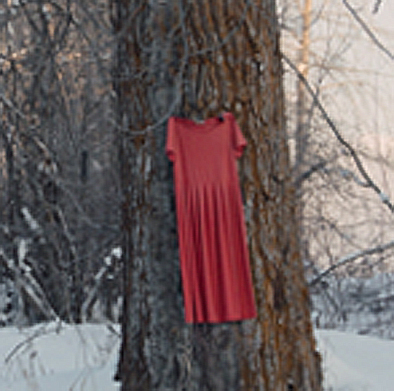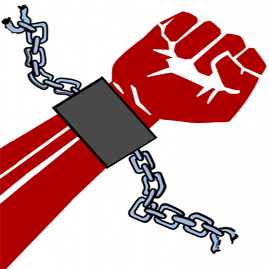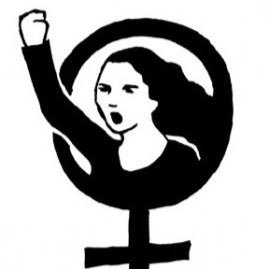| |
When one hurts or kills a women
one hurts or kills hummanity and is an antrocitie.
Gino d'Artali
and: My mother (1931-1997) always said to me <Mi
figlio, non esistono notizie <vecchie> perche puoi imparare qualcosa da
qualsiasi notizia.> Translated: <My son, there is no such thing as so
called 'old' news because you can learn something from any news.>
Gianna d'Artali
CLICK HERE ON HOW TO READ
ALL PARTS OF THIS SPECIAL
<The stench of death>
<Canada's murdered indigenous women and girls.>

A red dress signifies Missing and Murdered Indiginous
women and Girls
[Copyright: Amber Bracken/Al Jazeera]

Between 8 Nov 2021 and 17 Feb 2022 AL Jazeera published a serial of
articles about femicides of Canadian Indigenous women and girls of which each word is so
heartbreaking that it takes a lot of courage to read the whole serial. Still I challenge you to do so! I divided it according to the
number of articles and quoted from them ending with a read more URL. All
articles were written by Brandi Morin (1 to 10) except the last one
(11th.) written by an Al Jazeera team:
Related:
<<The stench of death
On Canada's Highway of Tears.
By Brandi Morin
8 Nov 2021
In this six-part series, Al Jazeera tells the stories of some of the
Indigenous women and girls who have gone missing or been murdered along
an infamous stretch of highway in British Columbia, Canada. Warning: The
following article contains content that may be disturbing to some
readers.
British Columbia, Canada - Mike Balczer pensively traces the rim of a
white coffee cup on a frigid February morning. He takes a ponderous
breath and looks up. His hair is covered by a black and white bandana
and a cap. His trademark attire - black leather and black and white
flannel - bear the markings that distinguish him as a nomad - a Crazy
Indian Brotherhood nomad. The Crazy Indian Brotherhood started in
Winnipeg, Manitoba in 2007 and now has chapters throughout Canada and to
the south as far as California and Oklahoma. It resembles a motorcycle
gang, but Mike says the tough image is just for appearances. <We protect
women and children around here. We patrol the streets looking out for
the vulnerable.> And the uniform helps to intimidate the town’s drug
dealers, he adds. But it is not only the local drug dealers who are on
Mike’s mind. He is on the prowl - looking for a killer, or possibly
killers, in Smithers. The small town in northwestern British Columbia
has a population of just over 5,300 people. It is home to the remnants
of settler frontiers and Indigenous nations in a valley between towering
snow-capped mountains, curtained by rows of lodgepole pine, spruce,
sub-alpine balsam fir, aspen, birch and cottonwood trees.
Although a confessed wanderer, Mike has called Smithers home on and off
for the past 20 years. He is a member of the Wit’Dat Nation (Lake Babine
Nation) about a two-hour drive east and as a hereditary chief is part of
a traditional governance system responsible for decision-making and
cultural practices. When he became a leader his elders gave him the name
<Person of Many>.
Mike’s ancestors were self-sustaining and flourished through an economy
based on inland fisheries until 1822 when missionaries arrived in the
territory. By 1836 a fur-trading outpost run by the Hudson’s Bay Company
(HBC) had been established at Lake Babine - the longest natural lake in
British Columbia and home to the Lake Babine Nation, today the
third-largest Indigenous band in the province, with more than 2,500
registered members. The HBC was at the helm of the British colonisation
of North America and allowed early white settlers to get rich off the
vast resources maintained by the Indigenous tribes during the fur trade.
Indigenous trappers, hunters and guides worked alongside Hudson’s Bay
employees to navigate the wilderness and harvest beaver and otter pelts
to ship to Europe. In return, the company traded industrial goods, guns,
European food and medicine with the First Nations. HBC also introduced
alcohol to Indigenous traders, many of whom became addicted to it. With
the arrival of settlers came foreign diseases like smallpox and measles
that wiped out thousands of Indigenous communities across the country.
In the 19th century, the Indigenous population of British Columbia was
estimated to be more than 125,000. But by 1929 there were just 22,000
Indigenous people left.
In 1876, the Canadian government introduced the Indian Act - a policy
that dictates the social, political, economic, spiritual and physical
lives of First Nations to this day. It created a reserve system that
herded First Nations onto small tracts of land in their traditional
territories. Then came the Indian residential school system which forced
Indigenous parents to send their children away to schools run by
churches where physical, emotional, verbal, sexual and spiritual abuse
was rampant. The Royal Canadian Mounted Police (RCMP) enforced the law
and threatened parents who refused to send their children to the schools
with jail time. The Truth and Reconciliation Commission of Canada (TRC)
estimates that more than 150,000 Inuit, First Nations and Metis (a
person of mixed Indigenous and European or American ancestry) children
attended these institutions between the 1870s and 1996, when the last
school was closed. Thousands of children died at the schools. These were
the conditions Mike’s ancestors survived - but the repercussions of
colonialism did not end with them. There is heartache and anger in
Mike’s demeanour. He has suffered a loss he believes he may never
recover from. The pain he feels is what drives him to seek justice -
justice for the death of his daughter, Jessica Patrick. Mike began
patrolling the streets of Smithers in 2020, a couple of years after
18-year-old Jessica was found dead off an embankment on the Hudson Bay
Mountain in 2018. <They (the authorities) put her in a steel box. It had
to be a closed casket because of the way they found her ...> He pauses
to hold back his tears, before stammering out the words, <she … was
deteriorated.> By the time she was found, nature had been feeding on
Jessica’s body for about two weeks. Mike last saw his petite, brown-eyed
daughter a couple of days before she went missing. It was August 2018
and he had driven from his home in Houston, an hour’s drive east of
Smithers, to meet Jessica, her 18-month-old daughter, Alayah, and other
family members at the town’s annual county fall fair. The father and
daughter had not always been together; there had been tough times when
Jessica was young. Mike and Jessica’s mother, Maureen Patrick, had
raised Jessica and her older brother until they split up when Jessica
was seven years old.
<Alcohol got in the way … ,> he explains, adding that both he and
Maureen struggled with addiction back then. The children were taken away
by child and family services and placed into foster care.>>
Read the whole article here:
https://www.aljazeera.com/features/longform/2021/11/8/the-stench-of-death-life-along-canadas-highway-of-tears
Snatched away
By Brandi Morin
18 Nov 2021
<<British Columbia, Canada - Jennie* jumps out of bed gasping for air.
She can hear the sound of twigs crunching and her own desperate screams.
Sometimes she kicks and punches. The commotion wakes her husband, who
tries to comfort her, to let her know she is safe. She never knows when
the nightmares will come. But when they do, they overwhelm her. <I tried
to get away, tried to scream, to do anything,> the 29-year-old explains
as she recounts the events of 10 years ago that play out - over and over
again - when she sleeps. <But I was just in shock.> Before that crisp
fall day in November 2010, Jennie says she led a relatively normal life.
She is Gitxsan First Nation, from Kitwanga, meaning People of the Place
of Rabbits, in northwest British Columbia. It is a spectacular landscape
of colossal jagged mountains, thick forests and freshwater rivers 241km
(150 miles) from the North Pacific Ocean. Kitwanga village lies on the
northern bank of the Skeena River, a bustling salmon migration route. It
is 3km (2 miles) from a national historic park called Battle Hill; a
knoll in a valley that was once a fortress occupied by a warrior chief
named Nekt. According to legend, the fortress was man-made, built to
repel outside raiders, and was the scene of epic tribal battles during
which it was defended by rolling large logs covered in spikes down upon
the attacking forces.
But no one was around to defend Jennie that day.
She was attacked just outside Kitwanga village along Highway 37, which
is one of only two routes from British Columbia to the Yukon Territory
and the State of Alaska to the north. It is just a few kilometres off
Highway 16 - a villainous stretch of road where dozens of mostly
Indigenous women and girls have disappeared or been found murdered since
the 1950s, earning it the moniker Highway of Tears. As a child, Jennie
lived more than an hour’s drive west of Kitwanga in the city of Terrace,
British Columbia. But when she was 11, her mother inherited her
grandfather’s home in Kitwanga and the family moved there. She loved the
opportunity it allowed her to learn about her culture, language and
traditional dance. But even then, she knew of the dangers that lurked
nearby. She had heard of Indigenous girls being snatched away along the
Highway of Tears, never to be seen again. But she had never imagined she
could be one of them. That November afternoon, Jennie missed the school
bus so she began walking home from her school in the centre of Kitwanga,
as she had done several times before. She remembers it being a chilly
but bright, sunny day. As she approached an area the locals call Snake
Hill - a steep, rounded hill on the highway that takes about 15 minutes
to climb - a white pick-up truck appeared from the top of the hill. It
slowed down as it approached her and the two white men inside began to
catcall. She ignored them and kept walking. <They were yelling, saying
that I was being disrespectful by not acknowledging them. Like I should
be grateful that they wanted to give me a ride. They told me they should
teach me a lesson.> She looks down; her hands are trembling. The men,
who she estimates to have been between 25 and 35 years of age, pulled
off into a side road, got out and began walking towards her. Sensing
danger, she dropped her checkered black and white backpack filled with
school books and ran. <I tried to throw it [the backpack] onto the road
because lots of people knew my bag and that I walked that way,> she
says, explaining that she wanted to leave some kind of evidence in case
she was murdered. <They tackled me down the side of the hill,> she says,
referring to the muddy, tree-filled embankment.
Her whole body begins to shake and she gasps for air. <They started
ripping my clothes off and I just remember the mud being cold…Both of
them raped me.> It is this that plagues her nightmares.>>
Read the whole article here:
https://www.aljazeera.com/features/longform/2021/11/16/snatched-away-the-indigenous-women-taken-on-the-highway-of-tears
|



